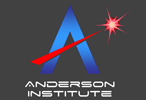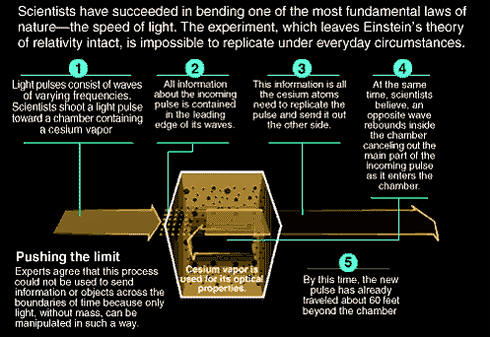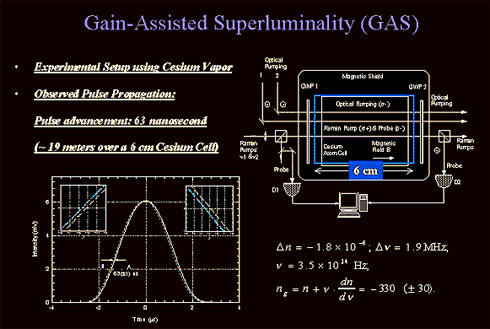Gain Assisted Superluminal Light Propagation
An article by Dr. Lijun Wang
The Speed of Light Is Exceeded in Lab
Scientists have apparently broken the universe’s speed limit. For generations, physicists believed there is nothing faster than light moving through a vacuum - a speed of 186,000 miles per second. But in an experiment in Princeton, N.J., physicists sent a pulse of laser light through cesium vapor so quickly that it left the chamber before it had even finished entering. The pulse traveled 310 times the distance it would have covered if the chamber had contained a vacuum. This seems to contradict not only common sense, but also a bedrock principle of Albert Einstein’s theory of relativity, which sets the speed of light in a vacuum, about 186,000 miles per second, as the fastest that anything can go. But the findings--the long-awaited first clear evidence of faster-than-light motion--are "not at odds with Einstein," said Lijun Wang, who with colleagues at the NEC Research Institute in Princeton, N.J., report their results in today’s issue of the journal Nature. "However," Wang said, "our experiment does show that the generally held misconception that ’nothing can move faster than the speed of light’ is wrong." Nothing with mass can exceed the light-speed limit. But physicists now believe that a pulse of light--which is a group of massless individual waves--can. To demonstrate that, the researchers created a carefully doctored vapor of laser-irradiated atoms that twist, squeeze and ultimately boost the speed of light waves in such abnormal ways that a pulse shoots through the vapor in about 1/300th the time it would take the pulse to go the same distance in a vacuum. As a general rule, light travels more slowly in any medium more dense than a vacuum (which, by definition, has no density at all). For example, in water, light travels at about three-fourths its vacuum speed; in glass, it’s around two-thirds. The ratio between the speed of light in a vacuum and its speed in a material is called the refractive index. The index can be changed slightly by altering the chemical or physical structure of the medium. Ordinary glass has a refractive index around 1.5. But by adding a bit of lead, it rises to 1.6. The slower speed, and greater bending, of light waves accounts for the more sprightly sparkle of lead crystal glass.
The NEC researchers achieved the opposite effect, creating a gaseous medium that, when manipulated with lasers, exhibits a sudden and precipitous drop in refractive index, Wang said, speeding up the passage of a pulse of light. The team used a 2.5-inch-long chamber filled with a vapor of cesium, a metallic element with a goldish color. They then trained several laser beams on the atoms, putting them in a stable but highly unnatural state. In that condition, a pulse of light or "wave packet" (a cluster made up of many separate interconnected waves of different frequencies) is drastically reconfigured as it passes through the vapor. Some of the component waves are stretched out, others compressed. Yet at the end of the chamber, they recombine and reinforce one another to form exactly the same shape as the original pulse, Wang said. "It’s called re-phasing." The key finding is that the reconstituted pulse re-forms before the original intact pulse could have gotten there by simply traveling though empty space. That is, the peak of the pulse is, in effect, extended forward in time. As a result, detectors attached to the beginning and end of the vapor chamber show that the peak of the exiting pulse leaves the chamber about 62 billionths of a second before the peak of the initial pulse finishes going in. That is not the way things usually work. Ordinarily, when sunlight--which, like the pulse in the experiment, is a combination of many different frequencies--passes through a glass prism, the prism disperses the white light’s components. This happens because each frequency moves at a different speed in glass, smearing out the original light beam. Blue is slowed the most, and thus deflected the farthest; red travels fastest and is bent the least. That phenomenon produces the familiar rainbow spectrum. But the NEC team’s laser-zapped cesium vapor produces the opposite outcome. It bends red more than blue in a process called "anomalous dispersion," causing an unusual reshuffling of the relationships among the various component light waves. That’s what causes the accelerated re-formation of the pulse, and hence the speed-up In theory, the work might eventually lead to dramatic improvements in optical transmission rates. "There’s a lot of excitement in the field now," said Steinberg. "People didn’t get into this area for the applications, but we all certainly hope that some applications can come out of it. It’s a gamble, and we just wait and see." |



